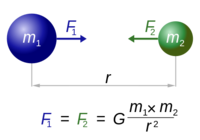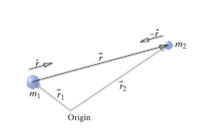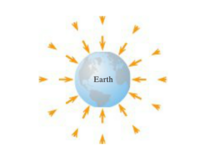Gravitational Force
CLAIMED BY BRIAN DUFFY
This topic covers Newton's Law of Universal Gravitation.
Created by Ankit Khanal.

Main Idea
Gravitational Force, defined in Newton's law of Universal Gravitation is the attractive force between any two bodies of any mass, at any distance. Gravity is one of the essential forces that hold the Universe together. The law states that every object in the universe is exerting a pulling force on each other that is directly proportional to the product of their masses and inversely proportional to the square of the distance between them. Gravitational Force is considered to be the weakest of the four fundamental forces of nature: strong nuclear force, electromagnetic force, weak nuclear force and finally gravity. The first test of this law was performed in the laboratory by the British scientist Henry Cavendish in 1798, 72 years after the death of Sir Isaac Newton.
History

Sir Isaac Newton, the 17th century English scientist, is popularly associated with gravity but scientists had been studying gravity for centuries before Newton. Based on Galileo’s and Kepler’s works, Newton published “Principia” in 1687, in which he explained that the force that makes planets move around the Sun is the same force that makes objects fall in the Earth. Newton explained that gravity is a force that attracts different masses and is inversely proportional to the square distance between the objects. However Newtons did not fully understand how gravitational force acted from one object to another over vast distances. Despite this flaw, this law has been used for more than three centuries and is still used by scientists. Albert Einstein rejected in theory and explained it in his general theory of relativity, in which he stated that gravity is not a force but it is a consequence of the curvature of space-time. Even Einstein did not fully explain gravitational force.
Application
A Mathematical Model
The gravitational law states that every mass attracts any other mass by a force acting on the line intersecting both points. The force is directly proportional to the product of the masses and inversely proportional to the square distance between them. The two masses involved are assumed to be of uniform size, and considered point masses.

- [math]\displaystyle{ |\vec{\mathbf{F}}_{grav}|= G \frac{m_1 m_2}{r^2}\ }[/math]
- where,
- F is the gravitational force between the masses;
- G is the gravitational constant [math]\displaystyle{ 6.674×10^{−11} \frac{N m^2}{kg^2}\ }[/math];
- m1 is the mass of the first object;
- m2 is the mass of the second object;
- r is the distance between the centers of both masses.
Vector Form
Newton's law of universal gravitation can be expressed in vector form to account for the direction of the gravitational force.
- [math]\displaystyle{ \vec{\mathbf{F}}_{grav}= -G \frac{m_1 m_2}{r^2}\ }[/math][math]\displaystyle{ \mathbf{\hat{r}} }[/math]

The relative position vector [math]\displaystyle{ \vec{\mathbf{r}} }[/math] is the distance from the center of object 1 to the center of object 2. The relative position between these two object can be represented as [math]\displaystyle{ \vec{\mathbf{r}}_{2-1} }[/math], which means that it is the difference between the position of object 1 and the position of object 2. The magnitude of [math]\displaystyle{ \vec{\mathbf{r}} }[/math], represented as [math]\displaystyle{ r^2 }[/math], is the distance between the center of two objects, found by taking the square root of the squares of each vector component. .
The direction of the gravitational force on object 2 by object 1 is specified by a unit vector,[math]\displaystyle{ -\mathbf{\hat{r}} }[/math], with a minus sign in front of it. The minus sign shows that the force on object 2 by 1 is in the opposite direction to [math]\displaystyle{ \mathbf{\hat{r}} }[/math].

Steps for calculating Gravitational Force
- Calculate [math]\displaystyle{ \vec{\mathbf{r}} }[/math] by using the position of the center of object 2 relative to the center of object 1, keeping this in vector notation. i.e. [math]\displaystyle{ \vec{\mathbf{r}} = \vec{\mathbf{r}}_2-\vec{\mathbf{r}}_1 }[/math]
- Calculate center to center distance between the objects, by finding the magnitude of the vector above [math]\displaystyle{ |\vec{\mathbf{r}}| }[/math]
- Calculate [math]\displaystyle{ |\vec{\mathbf{F}}_{grav}| }[/math] using the equation for gravitational force
- Calculate the unit vector [math]\displaystyle{ -\mathbf{\hat{r}} }[/math] =[math]\displaystyle{ \vec{\mathbf{r}} }[/math] /[math]\displaystyle{ |\vec{\mathbf{r}}| }[/math]
- Multiply the Magnitude, [math]\displaystyle{ |\vec{\mathbf{F}}_{grav}| }[/math], by the unit vector.
Gravitational Force near the surface of the Earth is calculated by using:
- [math]\displaystyle{ \vec{\mathbf{F}}_{grav} = mg }[/math]
- where,
- F is the force;
- g is the magnitude of gravitational field near the Earth's surface;
- m is the mass of the object.
This cannot be used for objects far from Earth or when determining the gravitational force from a different planet.
A Computational Model
A computational representation of Gravitational force can be created using VPython.
The code below show how we can find the net force, momentum and final position in Python.
while t < 235920:
rate(5000)
#Calculate the Gravitational Force acting on the craft due to Earth and Moon

#Craft to Earth Calculations
r = craft.pos - Earth.pos
rmag = sqrt(r.x**2 + r.y**2 + r.z**2)
rhat = r / rmag
fgravmag = -1 * ((G * mEarth * mcraft) / (rmag**2)) * rhat
#Craft to Moon Calculations
rmc = craft.pos - Moon.pos
rmcmag = sqrt(rmc.x**2 + rmc.y**2 + rmc.z**2)
rmchat = rmc / rmcmag
fgravmoon = -1 * ((G * mMoon * mcraft) / (rmcmag**2))*rmchat
#Fnet is sum of these two forces
fnet = fgrav + fgravmoon
From this we can calculate the change in momentum and the new positions using the net force.
#Update the position of the spacecraft by calculating the new momentum and the new velocity
pcraft = pcraft + (fnet*deltat)
vcraft = pcraft / mcraft
craft.pos = craft.pos + (vcraft*deltat)
Units
For the International System of Units(SI), Gravitational Force F is measured in Newtons (N), the two masses, m1 and m2 are measures in kilograms (Kg), the distance is measured in meters (m). Thus one Newton is equal to 1*(kg * (m/s2) and the gravitational constant G is measured in N m2 kg-2 and has a value of 6.674×10−11 N m2kg−2. The gravitation constant G is universal because no matter how big or small the masses are it is same for any interacting masses. The value of constant G appeared in Newton's law of universal gravitation, but he was not able to calculate it using the technology of the time. It was not measured until seventy two years after Newton's death by Henry Cavendish with his "Cavendish Experiment" in 1798. The finding of this value was the first laboratory test of Newton's Law of Universal Gravitation between two masses.
Examples
- Problems taken from Textbook and old Test on T-square
Simple
Determine the force of gravitational attraction between the earth (m = [math]\displaystyle{ 6 x 10^{24} kg }[/math]) and a 70 kg physics student if the student is in an airplane at 40,000 feet above earth's surface. This would place the student a distance of [math]\displaystyle{ 6.38 x 10^6 m }[/math] from earth's center.
The solution of the problem involves substituting known values of G ([math]\displaystyle{ 6.673 x 10^{-11} }[/math] N m2/kg2), m1 ([math]\displaystyle{ 6 x 10^{24} }[/math] kg), m2 (70 kg) and d ([math]\displaystyle{ 6.38 x 10^6 m }[/math]) into the universal gravitation equation and solving for Fgrav. The solution is as follows:
- [math]\displaystyle{ |\mathbf{F_{g}}| = G \frac{m_E m_M}{r^2} }[/math]
- [math]\displaystyle{ |\mathbf{F_{g}}| = 6.7x10^{-11} \frac{6e24 * 70}{6.38 x 10^6} }[/math]
- [math]\displaystyle{ |\mathbf{F_{g}}| =686 N }[/math]
Middling
The mass of the Earth is [math]\displaystyle{ 6 x 10^ {24} }[/math] kg, and the mass of the Moon is [math]\displaystyle{ 7 x 10^ {22} }[/math] kg. At a particular instance the moon is at location [math]\displaystyle{ \lt 2.8 x 10^8,0,-2.8 x 10^8\gt }[/math] m, in a coordinate system whose origin is at the center of the earth. (a) What is [math]\displaystyle{ \vec{\mathbf{r}} }[/math], the relative position vector from the Earth to the Moon? (b) What is [math]\displaystyle{ |\vec{\mathbf{r}}| }[/math]? (c) What is the unit vector [math]\displaystyle{ \vec{\mathbf{r}} }[/math]? (d) What is the gravitation force exerted by the Earth on the Moon? Your answer should be in vector.
The solution of the problem involves substituting known values of G ([math]\displaystyle{ 6.673 x 10^{-11} }[/math]N m2/kg2), m1 [math]\displaystyle{ 6 x 10^ {24} }[/math] kg, m2 [math]\displaystyle{ 7 x 10^ {22} }[/math] kg and d [math]\displaystyle{ \lt 2.8 x 10^8,0,-2.8 x 10^8\gt }[/math] m m into the universal gravitation equation and solving for Fgrav. The solution is as follows:

- (a) The position vector of Moon relative to Earth is,
- [math]\displaystyle{ \vec{\mathbf{r}} }[/math] = [math]\displaystyle{ \lt 2.8 x 10^8,0,-2.8 x 10^8\gt - \lt 0,0,0\gt }[/math]
- [math]\displaystyle{ \vec{\mathbf{r}} }[/math] = [math]\displaystyle{ \lt 2.8 x 10^8,0,-2.8 x 10^8\gt }[/math] m
- (b) The magnitude of position vector of Moon relative to Earth is,
- [math]\displaystyle{ |\vec{\mathbf{r}}| }[/math] = [math]\displaystyle{ \sqrt{(2.8 x 10^8)^2+0^2+(-2.8 x 10^8)^2} }[/math]
- [math]\displaystyle{ |\vec{\mathbf{r}}| }[/math] = [math]\displaystyle{ 4.0 x 10^8 }[/math] m
- (c) The unit vector of Moon relative to Earth is,
- [math]\displaystyle{ \mathbf{\hat{r}} = \frac {\vec{\mathbf{r}}}{|\vec{\mathbf{r}}|} }[/math]
- [math]\displaystyle{ \mathbf{\hat{r}} = \frac{\lt 2.8 x 10^8,0,-2.8 x 10^8\gt }{4.0 x 10^8} }[/math]
- [math]\displaystyle{ \mathbf{\hat{r}} = \lt 0.7,0,-0.7\gt }[/math]
- (d) The expression for the gravitational force on the Moon by the Earth is,
- [math]\displaystyle{ |\vec{\mathbf{F}}_{g}| = G \frac{m_E m_M}{|\vec{\mathbf{r^2}}|} }[/math]
- [math]\displaystyle{ |\vec{\mathbf{F}}_{g}| = 6.7x10^{-11} \frac{6 x 10^ {24} * 7 x 10^ {22}}{(4.0 x 10^8)^2 } }[/math]
- [math]\displaystyle{ |\vec{\mathbf{F}}_{g}| = 1.76x10^{20}N }[/math]
- [math]\displaystyle{ \vec{\mathbf{F}}_{g} }[/math] = [math]\displaystyle{ -|\mathbf{F_{grav}}|*{\mathbf{\hat{r}}} }[/math]
- [math]\displaystyle{ \vec{\mathbf{F}}_{g} }[/math] = [math]\displaystyle{ -1.76x10^{20}*\lt 0.7,0,-0.7\gt N }[/math]
- [math]\displaystyle{ \vec{\mathbf{F}}_{g} }[/math] = [math]\displaystyle{ \lt -1.232x10^{20},0,1.232x10^{20}\gt N }[/math]
Difficult
In the following problems you will be asked to calculate the net gravitational force acting on the Moon.To do so, please use the following variables:
- Mass
- mS - Mass of the Sun
- mE - Mass of the Earth
- mM - Mass of the Moon
- Initial Positions
- [math]\displaystyle{ \vec{\mathbf{r_{S}}} = \lt 0,0,0\gt m }[/math]- Position of the Sun
- [math]\displaystyle{ \vec{\mathbf{r_{E}}} }[/math] = <[math]\displaystyle{ L,0,0\gt }[/math] m- Position of the Earth
- [math]\displaystyle{ \vec{\mathbf{r_{M}}} }[/math] = <[math]\displaystyle{ L,h,0\gt }[/math] m - Position of the Moon
(a) Calculate the gravitational force on the Moon due to the Earth (b) Calculate the gravitational force on the Moon due to the Sun (c) Calculate the net gravitational force on the Moon
(a) The gravitational force on the Moon due to the Earth is,
- [math]\displaystyle{ \vec{\mathbf{r}} = \vec{\mathbf{r_M}}-\vec{\mathbf{r_E}} }[/math]
- [math]\displaystyle{ \vec{\mathbf{r}} }[/math] = <[math]\displaystyle{ L,h,0\gt }[/math]-<[math]\displaystyle{ L,0,0\gt }[/math]
- [math]\displaystyle{ \vec{\mathbf{r}} }[/math] = <[math]\displaystyle{ 0,h,0\gt m }[/math]
- [math]\displaystyle{ |\vec{\mathbf{r}}| = \sqrt{(0^2+h^2+0^2)} }[/math]
- [math]\displaystyle{ |\vec{\mathbf{r}}| = h }[/math] m
- [math]\displaystyle{ \mathbf{\hat{r}} = \frac {\vec{\mathbf{r}}}{|\vec{\mathbf{r}}|} }[/math]
- [math]\displaystyle{ \mathbf{\hat{r}} = \frac{\lt 0,h,0\gt }{h} }[/math]
- [math]\displaystyle{ \mathbf{\hat{r}} = \lt 0,1,0\gt }[/math]
- [math]\displaystyle{ |\vec{\mathbf{F}}_{g_1}| = G \frac{m_E m_M}{|\vec{\mathbf{r^2}|}} }[/math]
- [math]\displaystyle{ |\vec{\mathbf{F}}_{g_1}| = G \frac{m_E m_M}{h^2} }[/math]
- [math]\displaystyle{ \vec{\mathbf{F}}_{g_1} = -|\vec{\mathbf{F}}_{g_1}|*{mathbf{\hat{r}}} }[/math]
- [math]\displaystyle{ \vec{\mathbf{F}}_{g_1} = \lt 0,-G \frac{m_E m_M}{h^2},0\gt N }[/math]
(b) The gravitational force on the Moon due to the Sun is,
- [math]\displaystyle{ \vec{\mathbf{r}} = \vec{\mathbf{r_M}}-\vec{\mathbf{r_S}} }[/math]
- [math]\displaystyle{ \vec{\mathbf{r}} }[/math] = <[math]\displaystyle{ L,h,0\gt -\lt 0,0,0\gt }[/math]
- [math]\displaystyle{ \vec{\mathbf{r}} }[/math] = <[math]\displaystyle{ L,h,0\gt m }[/math]
- [math]\displaystyle{ |\vec{\mathbf{r}}| = \sqrt{(L^2+h^2+0^2)} }[/math]
- [math]\displaystyle{ |\vec{\mathbf{r}}| = \sqrt{(L^2+h^2)} }[/math]
- [math]\displaystyle{ \mathbf{\hat{r}} = \frac {\vec{\mathbf{r}}}{|\vec{\mathbf{r}}|} }[/math]
- [math]\displaystyle{ \mathbf{\hat{r}} = \frac {\lt (L,h,0)\gt }{\sqrt{(L^2+h^2)}} }[/math]
- [math]\displaystyle{ |\vec{\mathbf{F}}_{g_2}| = G \frac{m_S m_M}{|\vec{\mathbf{r^2}|}} }[/math]
- [math]\displaystyle{ |\vec{\mathbf{F}}_{g_2}| = G \frac{m_S m_M}{L^2+h^2} }[/math]
- [math]\displaystyle{ \vec{\mathbf{F}}_{g_2} = -|\vec{\mathbf{F}}_{g_2}|*{\mathbf{\hat{r}}} }[/math]
- [math]\displaystyle{ \vec{\mathbf{F}}_{g_2} = \lt -G \frac{m_S m_M L}{(L^2+h^2)^{3/2}},-G \frac{m_S m_M h}{(L^2+h^2)^{3/2}},0\gt N }[/math]
(c) The net gravitational force on the Moon is,
- [math]\displaystyle{ \vec{\mathbf{F}}_{net} = \vec{\mathbf{F}}_{g_1}+\vec{\mathbf{F}}_{g_2} }[/math]
- [math]\displaystyle{ \vec{\mathbf{F}}_{net} = \lt 0,-G \frac{m_E m_M}{h^2},0\gt +\lt -G \frac{m_S m_M L}{(L^2+h^2)^{3/2}},-G \frac{m_S m_M h}{(L^2+h^2)^{3/2}},0\gt }[/math]
- [math]\displaystyle{ \vec{\mathbf{F}}_{net} = \lt -G \frac{m_S m_M L}{(L^2+h^2)^{3/2}},-G \frac{m_E m_M}{h^2}-G \frac{m_S m_M h}{(L^2+h^2)^{3/2}},0\gt N }[/math]
Connectedness
- Nothing interests or intrigues me as much as outer space, and the first step to understanding that is to understand the Law of Universal Gravitation. The only reason we are alive today, and part of the solar system we are in is because of the force of gravity. It controls the tides of the oceans, the orbit of Earth, and the distance of planets to the Sun (which are vital for the survival of life). It is one of the most basic concepts you learn in physics, but one of the most important of the natural forces that work to keep our universe in balance.
- As a Mechanical Engineering major, gravitational force could be important if I ever work in the aerospace field, where you must determine how much lift an airplane or spaceship needs to get off the ground in order to counteract the force of gravity. Also, if I ever assist in the designing of buildings, it is important to know all of the forces that act on them, including gravity.
- Newton's Law of Universal Gravitation acts on every single object that you see around you every day. Without it, football games would be no fun because the ball would never come back to the ground, and also because all the players and spectators would be floating off into space. If a planet or object in space has a different orbit than expected, then it can be used to find new bodies that cause that change in orbit. If we did not know the force of gravity, we would not know how fast rockets need to travel to exit the atmosphere, and how high satellites must float in order to stay in the orbit the Earth. The Apollo 13 crew would never have been able to make it back to their families had Houston not known the exact gravitational forces that the moon could exert on the spacecraft.
See also
- For an interesting lab on the Law of Universal Gravitation visit here
- For more information and applications pertaining to the gravitational force visit here
Further reading
Matter and Interactions By Ruth W. Chabay, Bruce A. Sherwood - Chapter 3
External links
- 1: http://www.physicsclassroom.com/Class/circles/u6l3c.cfm
- 2: https://www.youtube.com/watch?v=0hOuNtRMSAI
- 3: http://csep10.phys.utk.edu/astr161/lect/history/newtongrav.html
- 4: http://www.animations.physics.unsw.edu.au/jw/gravity.htm
- 5: http://sandyabouttechnology.blogspot.com/2012/09/gravitation-force-and-application.html
References
- 1: "Newton's Law of Universal Gravitation." Newton's Law of Universal Gravitation. N.p., n.d. Web. 27 Nov. 2015.<http://www.physicsclassroom.com/Class/circles/u6l3c.cfm>
- 2: Rankin, Alan. "What Is a Gravitational Force?" WiseGeek. Conjecture, n.d. Web. 28 Nov. 2015. <http://www.wisegeek.com/what-is-a-gravitational-force.htm>
- 3: "History of Gravity." History of Gravity. N.p., n.d. Web. 28 Nov. 2015. <https://www.physics.wisc.edu/museum/Exhibits-1/Mechanics/GravPit/index_HistGrav-2.html>